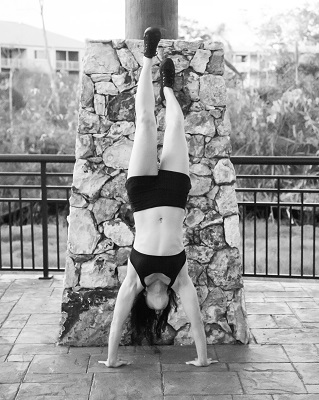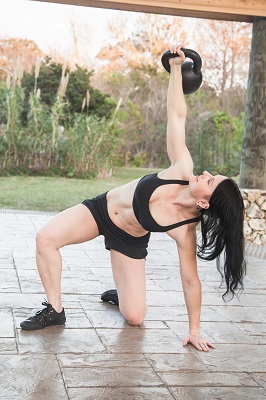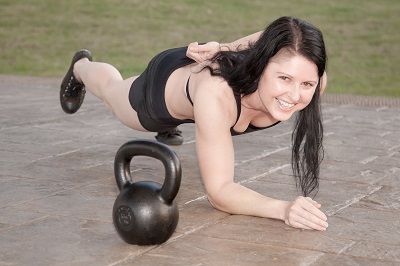Since many of us who practice Progressive Calisthenics are often involved with other athletic pursuits like kettlebells, martial arts, and/or sports, a question which continually comes up is how to program our sessions in a way that allows for high performance in some areas and at least maintenance in others. People beginning the Convict Conditioning program sometimes ask a similar question, thinking that they need to “add in” cardio, thinking that the program somehow isn’t “enough” on its own for fat loss or other physique-related goals. The good news is, the program can absolutely stand on its own, it’s just very different from the familiar sets-reps-weights-n-cardio paradigm. It’s important to realize that the bodyweight programs as presented in Convict Conditioning are complete, and use a strategy which is entirely different from mainstream “conventional” approaches.
For fat loss, it isn’t really necessary for someone to have to add steady state cardio. An improved nutritional plan and consistent work with Convict Conditioning should produce incredible results. Especially when this beginning calisthenics athlete begins to really feel, on a visceral level, how their performance is enhanced by getting stronger, and by becoming a little lighter. This sort of dual reinforcement is powerful—it can motivate people to permanently adopt a healthier lifestyle. Given the program’s power, athletes participating in competitive sports, martial arts, or other athletic pursuits like kettlebells will want to keep this in mind when programming. Motivated athletes of all kinds seem to short change their rest and recovery.
I’ll be giving an example week of how I have made a Convict Conditioning program work within my own lifestyle of instructing, maintaining, and further refining RKC kettlebell skills while still creeping towards some fairly big long-term bodyweight goals (1 arm chin up, human flag, etc). A few of the routines in CC are specifically designed with enough rest days to allow for the inclusion of sports. Good Behavior and to a lesser degree Hard Time are great examples. Hard Time is especially upper body focused, so if your “extracurricular activities” are particularly upper body inclusive you may wish to choose a different routine to work with.
An important thing to remember with both Convict Conditioning and kettlebell training is that less is often more. Convict Conditioning requires absolutely strict form and coordinated full body tension with each exercise—while not training to failure (and theoretically still leaving you enough energy to defend yourself). In my opinion, practicing Progressive Calisthenics, like kettlebell training, is as much about building skill as it is about building raw strength. Often on Facebook and other online communities we see some very ambitious sounding workouts with just amazing rep ranges, but it’s important to remember that these longer duration workouts will have performance and form trade offs. Think of a marathon vs. a sprint—to run a marathon, the athlete will need to pace themselves. In a sprint, the athlete will basically go “all out” for a short period of time. Personally, I like shorter duration workouts aimed towards skill building, optimal movement patterns, and the control of maximum tension where needed in each rep. Most days my “workouts” tend to be small, near maximal sets of very challenging exercises spread throughout the day. The CC logbook is especially great for keeping track of these activities.
Since maintaining and refining kettlebell moves is essentially my current “sport” or “martial art” right now, a program like Good Behavior can be easily adapted for several weeks of progressive training. The weeks following the example below would have variations in kettlebell exercises and weights, and if appropriate (the progression standard met) a graduation to the next step in a given Convict Conditioning progression. The names of the calisthenics exercises refer to wherever I am in the progression. This is a fairly typical example of my training on a non-traveling week, adapting the Good Behavior routine:
Monday: Push Ups – 2 Work Sets*; Leg Raises – 2 Work Sets
Optional kettlebell swings and a few get ups as a warm-up, or to break up a typical Monday heavy on business, writing, or internet work.
Tuesday: Moderate kettlebell work (RKC snatch test or slightly heavier bell) technique workout for get ups, swings, high pulls, and snatches. RKC Planks and hollow position holds. Rep range is significant but nothing spectacular.
Wednesday: Pull Ups – 2 Work Sets; Squats – 2 work sets Optional swings and/or get ups. After the work sets of pull ups and significant rest, I might play-practice with pull up variations and or a muscle up or two along with dragon flags and working towards the “human flag” here and there in the day.
Thursday: Rest/Mobility/Extra tai chi skills practice and/or Extra Primal Move mobility/skills work
Friday: Handstand Push Ups – 2 work sets; Bridges – 2 work sets
Saturday: A kettlebell challenge circuit workout – usually includes pressing and/or clean&jerks, along with an extra implement or challenge like Battling Ropes or flipping tires. Play with advanced variations of a CC exercise, or a PR attempt of some kind.
Sunday: Rest/Recovery/Mobility
*Work sets in Convict Conditioning are preceded by a few warm up sets of earlier parts of the progression, the book has all the details and several workout routines like Good Behavior for you to start working with immediately.
—
About Adrienne Harvey, RKCII, CK-FMS, Primal Move Nat’l Instructor
I started studying kettlebell training over three years ago and became RKC Certified in October of 2010, and became an RKC Level 2 Instructor in July 10th of 2011. Kettlebell and bodyweight training have been absolutely crucial in my personal quest for fitness, and I love sharing these ultra-effective modalities with small groups and individuals. Similarly, developing recipes to further support performance, body composition, and general enjoyment is another passion. Go to http://www.giryagirl.com/ for more information about Adrienne!



